Menu
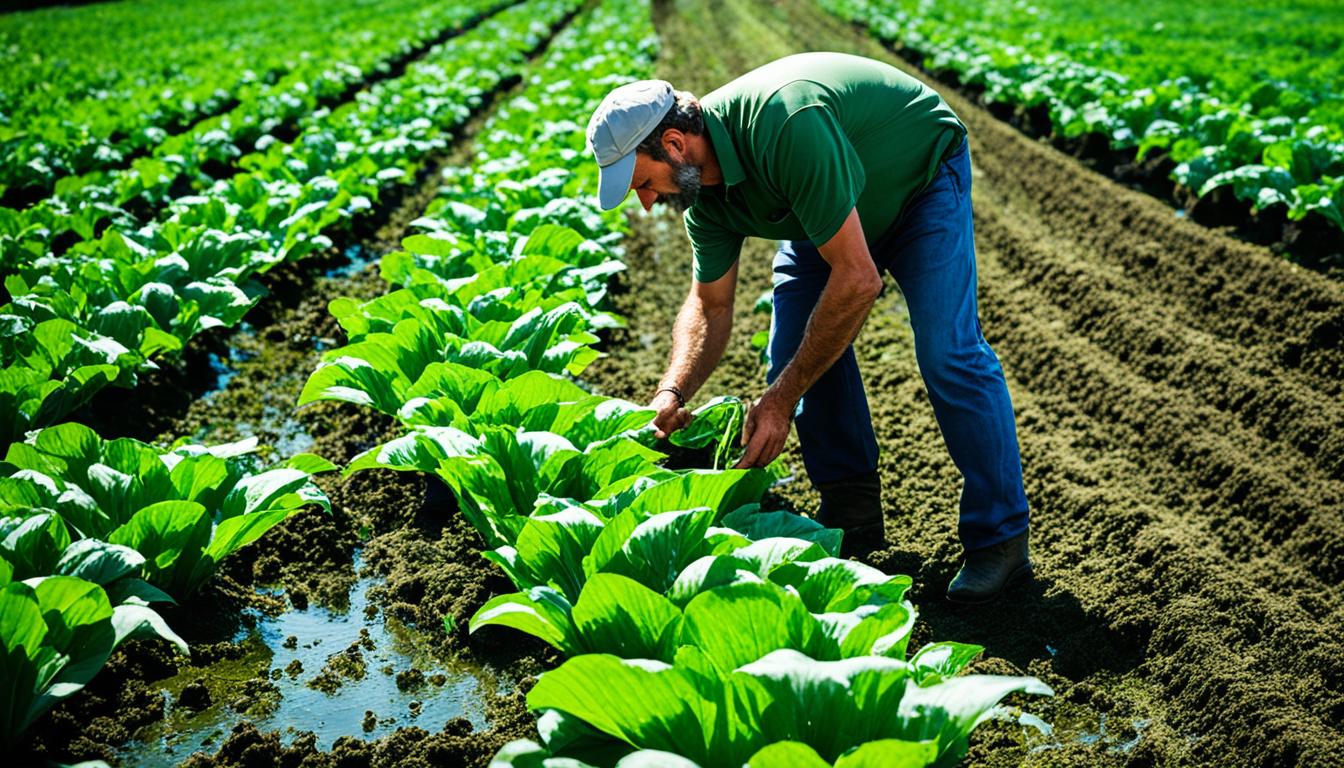
Did you know that agricultural nonpoint source (NPS) pollution is recognized as a top water quality problem? This comes from the 2000 National Water Quality Inventory. It shows the urgent need to tackle the environmental effects of farm runoff.
Water pollution from farms is a big deal. Poor handling of pesticides, fertilisers, and animal waste by farmers risks both water and soil. Fertiliser leakages have nitrous oxide, which is a potent greenhouse gas. It can harm the soil and water, making them unsafe for people and animals.
Amazingly, farmers can cut erosion and sediment significantly by 20 to 90 percent with the right management. Also, more than 40 percent of section 319 Clean Water Act funds are used to fight NPS pollution from farms. This shows the huge effort to lessen farming’s impact on water quality and the environment.
In the U.S., about 238,000 farms act as animal feeding sites and produce 500 million tons of manure yearly. It’s critical to control the amount and speed of runoff to keep our water clean and farms safe. By applying techniques like conservation tilling and using grassed waterways, farmers can effectively deal with runoff. This helps keep the ecosystem healthier.
Agricultural runoff comes from things like using pesticides, putting on fertilisers, and handling animal waste. It poses big risks to our environment. This runoff affects soil and crop quality, local water sources, and helps climate change. We need good plans to manage this and find solutions to avoid harm.
Runoff can harm soil by changing its pH and nutrient levels, making it hard for crops to grow. Using smart ways to control water pollution in farming, like conservation tilling, is key. This method helps prevent soil erosion. It covers at least 30% of soil with plants. It keeps the soil’s nutrients in balance, supporting healthy crop growth.
Runoff with animal waste and pesticides badly affects local waters. The 2000 National Water Quality Inventory found that farm pollution is the top cause of water damage in rivers and lakes. A lot of money, over 40%, from the Clean Water Act helps farms stop this pollution. Solutions like grassed waterways and water basins prevent water contamination.
Fertiliser runoff is a big worry for climate change because it releases nitrous oxide. This gas is about 300 times worse than carbon dioxide. To fight this, the Farm Bill provides $13 billion for conservation. These steps are important to deal with today’s harm and prevent future extreme weather.
It’s very important we keep finding the best ways to control water pollution from farming. With good plans and laws, we can curb the negative impacts of farm runoff on our environment.
To reduce pollution in farming, we need to cut down on pesticides. This helps lower agricultural runoff and keeps nature in balance. Farmers use methods like companion planting and natural predators to lessen the use of chemical sprays. This makes the environment healthier.
Farmers in sustainable agriculture use non-chemical ways to fight pests. They set up nets and traps as barriers. They also choose crops that pests don’t like. This reduces the need for harmful pesticides.
Companion planting is a clever way to stop pests. By growing marigolds and basil near crops, pests are put off. These plants give off smells that insects dislike. This means less chemical sprays and less runoff.
Natural predators play a big role in farming without pesticides. Ladybugs, nematodes, and spiders eat harmful insects. This control is organic, preserving the environment and cutting down on pollution in water.
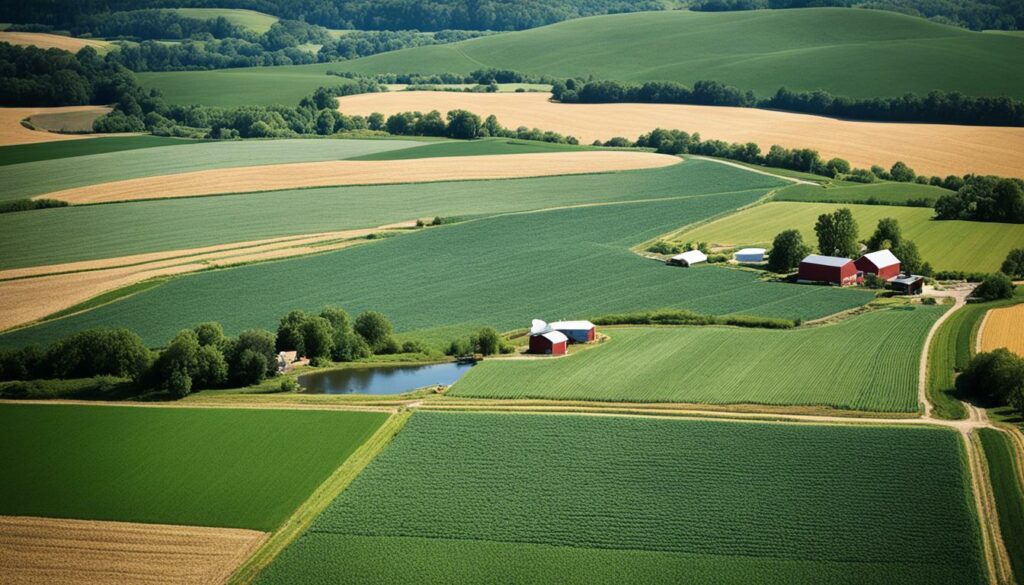
| Pest Control Method | Description | Benefits |
|---|---|---|
| Physical Barriers | Using nets and traps to protect crops | Reduces chemical use, eco-friendly |
| Pest-Resistant Varieties | Growing crops that naturally repel pests | Minimises pesticide need, enhances yield |
| Companion Planting | Planting deterrent species alongside crops | Reduces pests, improved soil health |
| Natural Predators | Introducing insects like ladybugs | Controls pest population, promotes biodiversity |
Good irrigation systems are key for managing water sustainably in farming. Over half the world’s food uses managed water. These systems save water and reduce pollution from agriculture. They need both regular checks and smart changes to work better and pollute less.
It’s vital to check and look after irrigation gear to stop leaks and overflows that pollute water. Examples from the Central Valley in California show big benefits from keeping up high standards. By keeping their gear in top shape, farms that use irrigation in the U.S. see much better crop growth than those without it.
Using water more wisely in farming aims to waste less and stop runoff. For example, farming methods like conservation tilling, where a lot of land is covered with plants, keep the soil moist and cut down on soil loss. This is extra important in areas where many fields see big changes in crops because of moisture changes. So, using water wisely in farming helps with water and pollution concerns.
| Statistic | Value |
|---|---|
| Percentage of Global Food Supply Dependent on Water Management | Over 50% |
| Percentage of Cultivated Areas Using Irrigation | 18% |
| Total World Food Production from Irrigated Areas | 40% |
| Average Crop Yield Improvement for Wheat (Irrigated vs. Dryland) | 118% |
| Average Crop Yield Improvement for Corn (Irrigated vs. Dryland) | 30% |
| Similarity in Unstable Yield due to Soil Moisture Variations | 25% – 33% |
Caring for irrigation tools and using water in new ways can boost how much food we grow and harm nature less. This way, farmers help fix water pollution problems and keep our planet healthier.
Conservation tilling is key for best practices for water pollution control in agriculture. It leaves most of the crop or cover crops on the ground. This cuts down soil erosion and stops runoff from agriculture, a big water pollution source.
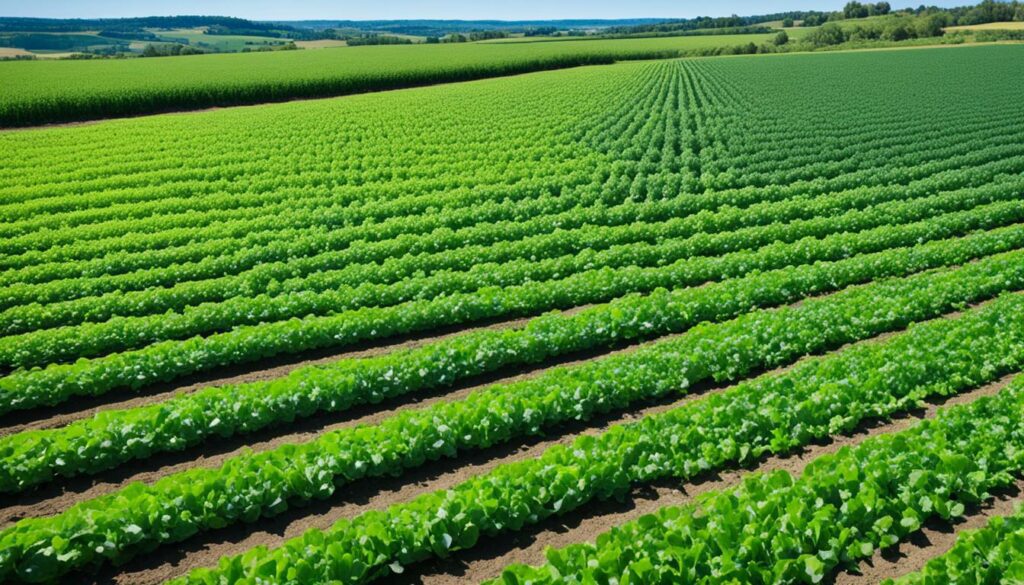
Its benefits are clear from many studies. A study from 1992 found farming caused a lot of dirt, nutrients, and pesticides in water. Yet, using conservation tilling can lower this. It cuts down how much silt, nutrients, and pesticides get into water bodies from runoff.
No-till systems are great. They can lessen herbicide runoff by 70% compared to traditional methods. But, it’s important to watch out. If it rains heavy right after spraying herbicides, there could be more runoff.
Conservation tillage also helps the soil in a good way over time. It can create paths for water to flow better. This can reduce the risk of nitrogen seeping into the water.
Groundwater pollution risk depends on how these tilling methods are used and the weather. Rain after applying chemicals is a concern. So, knowing when to use these chemicals can help keep your land safe and improve its health.
Conservation tilling techniques involve covering at least 30% of the surface with plants and requiring 1,000 pounds per acre throughout critical wind-erosion periods.
Comparing data shows conservation tillage works. More crop residue equals less soil washing away. This means less dirt, nutrients, and chemicals reach the water through runoff. So, using conservation tilling fights back against water pollution in a big way.
Other methods, like grassed waterways and plant buffers, can also help. They stop soil and nutrients from reaching water bodies. This improves water quality and fights the overgrowth of algae, making the environment better for everyone.
Using methods like contour farming and terracing helps manage water well in agriculture. They lower water pollution by adjusting the natural ground and making water flow systems. By working with the shape of the land, farmers can use water movement better. This cuts down on waste and makes soil and crops better.
Contour farming means crops are planted in lines that match the land’s shape. This stops soil from being washed away and spreads water well. It really helps on hills where water might flood and hurt the soil.
Setting up these lines might be tricky because of the land’s bumps. But the good outcomes, like saving water and keeping soil moist, are worth it.
Terraces are like steps that slow down water flow on hills. This lets water soak in and keeps the ground healthy. Terraces that aren’t too steep help a lot of crops grow well. They were first used by the Incas and still work today to protect the land.
| Benefits | Details |
|---|---|
| Soil Erosion Prevention | Terracing decreases rill formations and reduces sedimentation. |
| Water Conservation | Terraces slow down water runoffs and enhance infiltration. |
| Improved Crop Growth | Better soil moisture and nutrient levels increase food production. |
| Ecosystem Diversity | Terrace farming supports diverse crop cultivation and soil health. |
These farming methods help raise productivity and cut down on damage to the environment. They deal with water issues now and help farming in the long run. Using both old and new ways shows farming can be strong and good for the planet.
Looking after water and sediments is key in keeping water quality in good shape on farms. Addressing the negative effects of farm runoff, water and sediment-control basins are vital. They work by catching runoff and sediments. Berms and underground outlets then guide the water effectively. Let’s look deeper into the important parts that make these basins work.
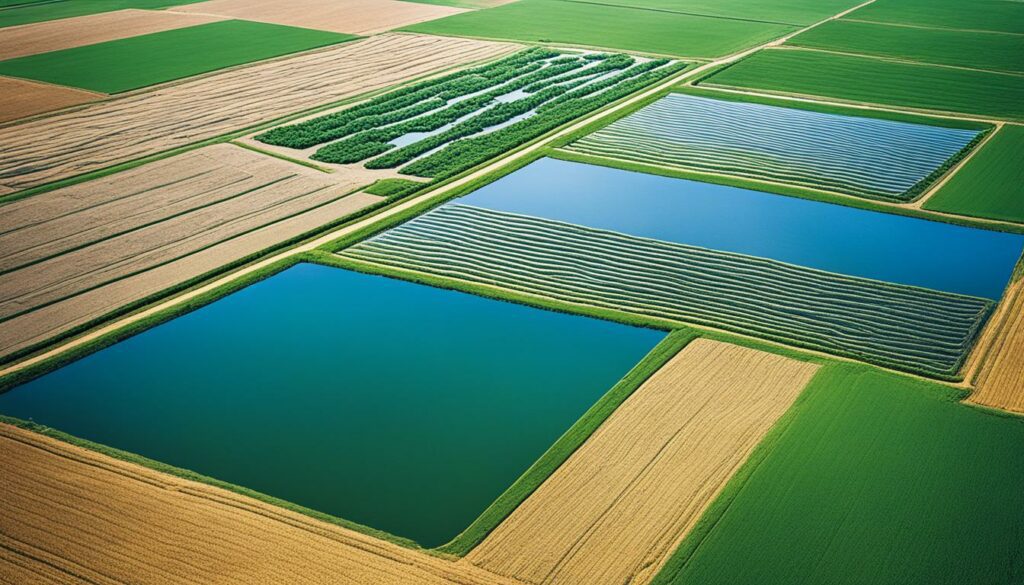
Berms are vital in water and sediment-control basins. They’re placed at the bottom of hills to hold back water and soil. This greatly lowers the risk of runoff carrying harmful stuff into waterways. Particularly, they reduce the spread of nitrous oxide, which is a potent greenhouse gas from fertilisers. Berms protect soil and help with water quality.
Underground outlets are key in making basins work well. They guide excess water away carefully to stop erosion and pollution of streams and rivers. This method helps control farm runoff. It also tackles problems like soil becoming too alkaline for plants. In short, underground outlets improve our water management, safeguarding our water sources.
Grassed waterways are a great option for managing water on farms. They use grass to stop soil from washing away and to cut down the amount of water that leaves fields. This means less farm chemicals getting into rivers and lakes, making them cleaner. Studies from places like Kewaunee County show that using grassed waterways reduces soil loss by up to 99%. This keeps soil healthy and the environment in good shape.
Grassed waterways are key in stopping soil from eroding. With more rain than usual, runoff and soil loss have gone up. Grassed waterways stop water from taking soil with it. Studies, like the ones from Discovery Farms, show how important they are for keeping fields and waterways clean. They work best when used alongside other land protection methods.
Grassed waterways also help keep nutrients from leaving fields. These grassy channels hold onto nutrients, helping to purify the water. They are a top choice in farming for keeping water clean. The Kentucky Agriculture Water Quality State Plan highlights their importance in managing runoff. To work well, the grassed waterways need to be installed and looked after properly.
| Practice | Benefits | Study/Location |
|---|---|---|
| Grassed Waterways | Up to 99% reduction in soil loss | Kewaunee County |
| Grassed Waterways | Significant nutrient and sediment retention | Kentucky State Plan |
| Combined with Upland Practices | Enhanced water quality outcomes | Various Studies |
Guarding streams and shorelines against farm runoff is key to managing water pollution in agriculture. We must create vegetated buffer zones and control where livestock go. These actions clean the water, stop pollution, and keep the banks solid.
Buffer zones have grass and plants to slow down water, catch dirt, and clean nutrients. They are critical for pollution prevention in farming by letting water soak into the ground. This stops harmful substances reaching our water, helping prevent problems like erosion and pollution.
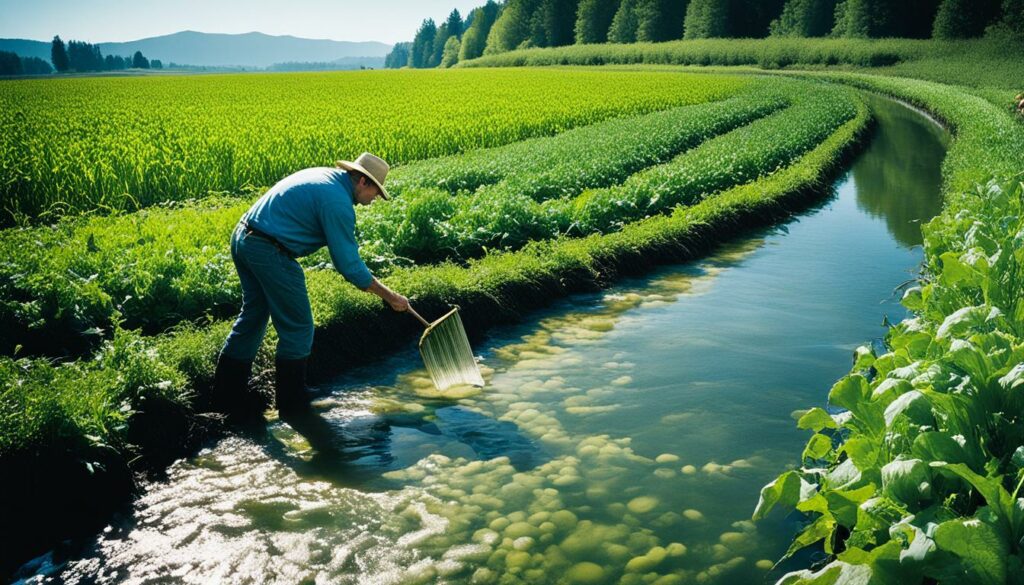
Keeping livestock away from streams includes building special paths and fences for them to follow. This helps keep the water cleaner and the land undisturbed. It’s crucial for dealing with issues like harmful bacteria from animal waste and too many nutrients that can hurt plants.
It’s vital to manage water well on farms to fight water pollution. Doing this keeps farming practices sustainable. Many strategies help lessen the harm from these operations on the environment.
Improving animal feeding management is a key sustainable agriculture techique. Keeping animals in carefully controlled spaces helps a lot. This way, we can control their food, water, and waste. It stops waste from getting into our rivers and streams, which is a big source of pollution.
This strict way of managing things can really cut water pollution. The Environmental Protection Agency says that 70% of river and stream pollution comes from waste runoff. It affects more than 173,000 miles of waterways in the US.
Looking after where animals graze is also crucial. It stops the ground from becoming too worn out and from soil washing away. This is a big problem happening in drylands. Without careful grazing management, the land can lose its plants that protect the soil from erosion. Imagine, a beef feedlot with 1,000 cows makes about 21,000,000 pounds of manure each year. Proper handling is vital for the environment.
In places like Denmark, there are laws that set the most pollution a farm can make. They also tax chemicals that are bad for the environment. This helps make farming better for everyone. But there must also be good plans and studies on water quality to keep track of pollution well.
To wrap up, managing water well on farms takes using several strategies. These aim to lower pollution and keep the environment healthy. Using these ways, farmers can make water cleaner and ensure their farms are sustainable for the long run.
In today’s farming, nutrient management plans are key for top productivity and eco-friendly farming. By using these plans, farmers can avoid applying too many nutrients. This helps in keeping water clean.
Applying the right nutrients needs knowledge of the soil and what the crops need. It’s essential to test the soil thoroughly. This way, farmers determine exactly what nutrients to add. Knowing the soil’s nutrient levels helps avoid using too much, which can hurt water quality.
As seen in manure samples from Pennsylvania, nutrients in soils vary a lot. This shows why using personalised nutrient plans is better than just following general advice. A specific approach ensures the nutrients match what the crops need. This reduces runoff that could pollute water bodies.
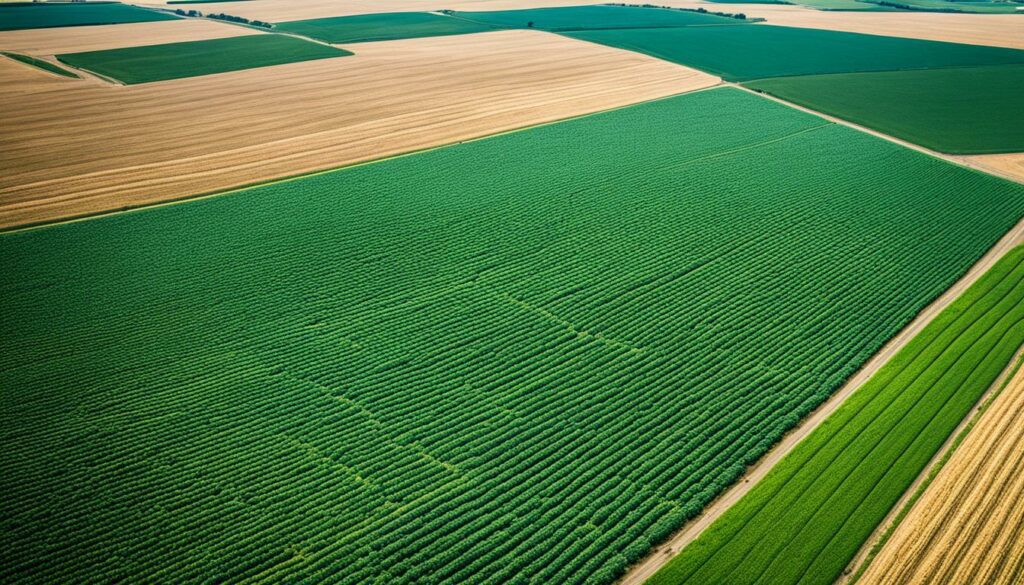
Applying too many nutrients can harm water by adding too much nitrogen and phosphorus, either directly or through runoff. To fight this, today’s rules require farms to manage nutrients to prevent pollution. These plans help set the right manure doses for crops, not too much and not too little.
The right time to fertilise is also key. It should match when the crops take in nutrients the most. This makes sure fertiliser is effective and doesn’t end up in the water.
To fight pollution further, farms use soil-friendly methods, helped by a big $19.5 billion fund. This is under the Inflation Reduction Act. With these methods, farmers can help reduce climate damage from their work.
Using the right tools for nutrient management brings many benefits, without costing a lot. These tools help plan nutrient use well, which is good for the farm’s money and the planet. The USDA is working to offer more of these helpful tools. This helps farmers follow smart eco-friendly farming better.
Heavy rains are hitting the Northeastern United States more often. This leads to soil erosion and nutrient loss from farms. Wet spring and fall weather are also cutting down the days farmers can work. Cover crops are stepping in to help tackle these challenges.
Cover crops are great at fighting water pollution in farming. They boost soil health, fertility, and catch extra nutrients. These crops hold more moisture in the soil, essential for heavy rains. They stop soil erosion and keep nutrients from running off. By making soil less compact, they help control pests.
Cover crops can also be good for a farmer’s wallet. They increase crop yields, cut down on machinery use, and beat weeds. They interrupt the growth of harmful bugs and diseases. Plus, they invite helpful creatures and pollinators, while helping clean the soil. Though they cost money to seed and plant, the benefits show over time.
Certain cover crops meet different farm needs. It’s important for farmers to choose what fits their land and climate. Legumes help by adding nitrogen to the soil, which boosts fertility. Grasses are good at holding nutrients and keeping soil in place.
But there are some issues to watch out for too. Cover crops might use up nitrogen or water, possibly reducing future crop yields. The outcome depends on the climate and how they’re managed. Yet, their water drainage benefit is key for prepping fields for planting.
The USDA is getting behind cover crops too. In 2021, they supported the planting of 2.3 million acres through the EQIP. Also, the RMA gave $59.5 million to help cover crop planting on 12.2 million acres. These supports show growing interest in sustainable farming methods.
Integrated Pest Management (IPM) has greatly helped in using sustainable farming methods and cutting down on agricultural waste. IPM looks at the bigger picture to address pest problems. It focuses on preventing them in the first place. This approach is better for the environment than just using lots of chemicals.
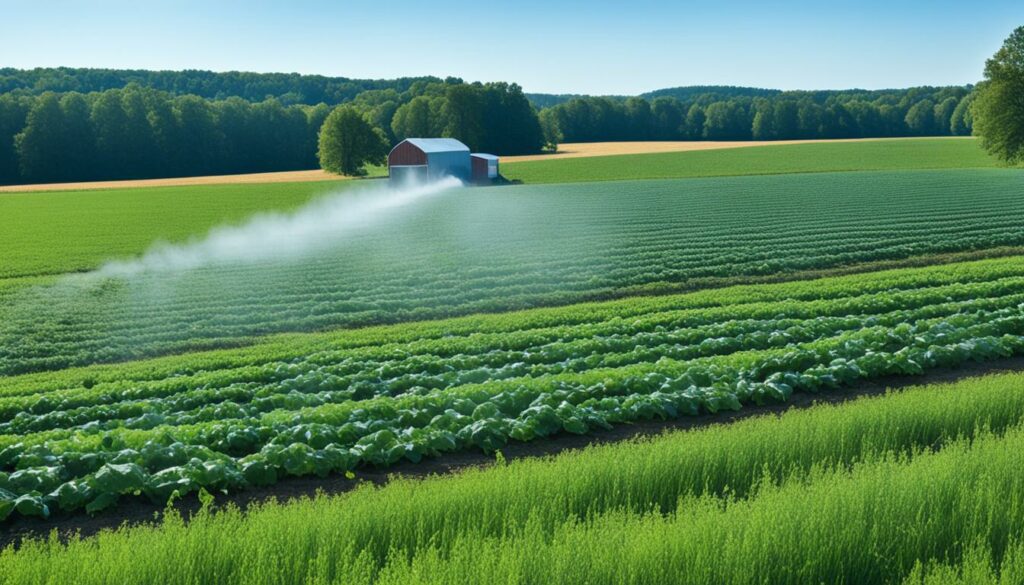
IPM is all about knowing the pests and using smart tactics to deal with them. Since 1979, the UC Statewide IPM Program has taught us a lot. It says we should check pest numbers and types first. This helps us avoid using chemicals when we don’t need to. So, we help keep our water cleaner from pesticide runoff.
IPM uses many different ways to control pests:
Making IPM work for your area is key to its success. The UC IPM program helps figure out what works in different places. Take California, for instance. Its varied farms need special IPM plans. By using local information and knowing about pests, farmers can stop them more effectively. This not only helps with farming waste but also meets the goals of eco-friendly farming.
Government and community help are key in fighting agricultural water pollution. They provide money and expertise. This aid is vital for better water use in farming.
The Farm Bill and local groups give farmers resources. From 2018 to 2020, the NRCS helped spread conservation across 1.26 million acres in the Chesapeake Bay area. That’s as big as the Grand Canyon National Park. Such help encourages farmers to use water better in their fields.
The USDA also invests a lot. In 2022, they put in an extra $22.5 million for the Chesapeake Bay. Thanks to these funds, farmers can adopt eco-friendly practices long-term.
Many areas have seen big improvements. For example, the MRBI saw a 30% rise in good water use thanks to targeted spending. The GLRI has cut phosphorus by 1.1 million pounds in certain spots since 2010. These are big achievements from focused efforts.
Sinthe 2012, the NWQI has worked with over 5,600 farmers to better water use on 1,190,000 acres. As a result, at least 16 previously damaged water spots are now better off. These projects show that with enough money and help, real progress is possible.
With proper funding, guidance, and check-ups, we can do a lot. These steps are crucial for farmers. They help achieve good water use, making our surroundings healthier and farms more productive.
To fight water pollution in agriculture, we must cover both soil and water’s health. The best practices cut down on pollution from farming, the main source of poor water quality. According to a report in 2000, this pollution is the top reason for water not being clean.
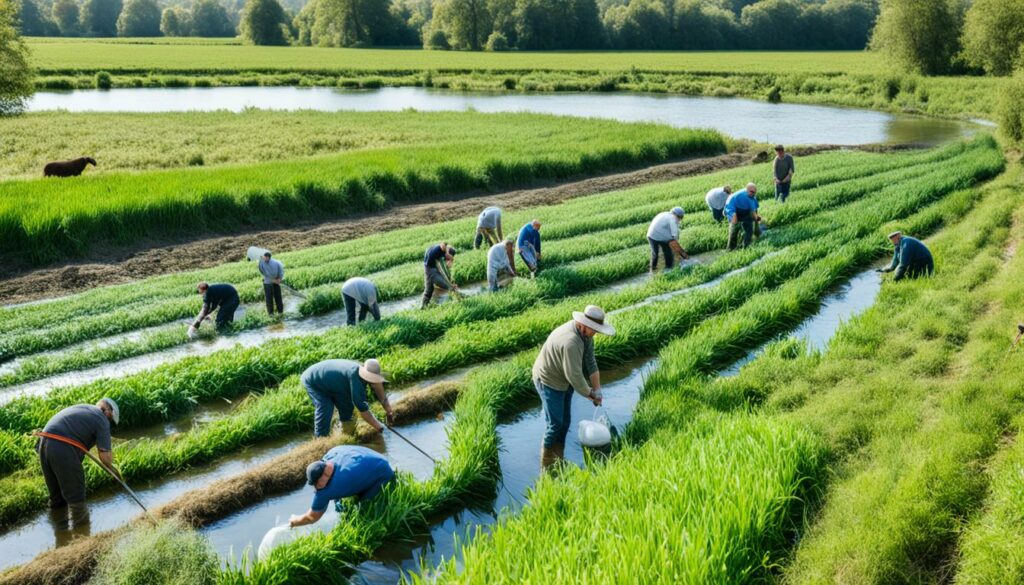
Farmers have several tactics to fight water pollution. They can manage nutrients better to lower the risk of runoff. This means carefully adding the right amount of nutrients without overdoing it. Also, strategies like conservation tilling can slash soil erosion. This tactic alone can drop erosion and sediment by 20 to 90 percent.
Improving irrigation is also key. By giving crops only the water they need, farmers cut the pollution risk. Using Integrated Pest Management (IPM) helps too. It relies less on chemical sprays, which cuts down on runoff of harmful substances into waterways.
Embracing these practices has big long-term gains. They help now with environmental worries but also keep farming sustainable. The Farm Bill from 2002 shows support for saving up to $13 billion for such efforts. This helps make water and land cleaner, leading to healthier natural places and crops.
Programs like the section 319 Clean Water Act focus on cutting down pollution from farms. They aim at around 238,000 farms producing lots of manure every year. These steps are essential for the future. They preserve the environment, boost health, and keep farming areas thriving.
It’s key to tackle water pollution from farming to keep our ecosystems and people healthy. Farming uses 70% of the world’s water and spends over USD 35 billion on pesticides each year. Using better methods, like smart irrigation and careful use of nutrients, can reduce the harm from farm runoff.
The amount of land we use for growing crops has more than doubled since 1961. Livestock numbers have also skyrocketed from 7.3 billion in 1970 to 24.2 billion in 2011. Tackling water pollution caused by agriculture is crucial. For example, in the European Union, 38% of water bodies face pollution from farming. With new ideas and strong support, we can cut down this pollution and save our water.
The damage caused by water pollution in OECD countries tops billions of dollars yearly. This shows we need to act fast. Studies in places like India and Italy highlight how new ways of monitoring help. By working together and using eco-friendly farming, we can make our water cleaner, grow better crops, and protect our planet for the next generation.
Agricultural runoff comes from excess water on farms from irrigation, rain, or melted snow. This water flows into rivers and seas, taking pesticides, fertilisers, and animal waste with it. It causes water pollution that harms soil, plants, and animals in those areas.
Sustainable techniques aim to keep the farm in balance with nature. They include special ways of planting, not turning the soil too much, and using natural methods to control pests. These steps help keep the soil healthy, reduce water pollution, and cut down on the use of harmful chemicals.
Farmers can use less pesticide by planting crops that pests don’t like and by using certain plants near each other. They can also introduce bugs that eat the bad pests. These methods help the farm’s ecosystem stay strong without needing lots of chemicals.
Good irrigation systems save water and stop it from carrying harmful things into the environment. By using water wisely and checking on the equipment, farms can waste less water. This keeps the water clean for everyone nearby.
Conservation tilling lets some parts of the farm stay covered with old crops or living plants. This helps stop rain and other water from washing soil away. It keeps the soil healthy and water clean.
Contour farming plants crops across the land’s natural curves, helping water sink into the soil instead of running off. Terracing builds steps into hillside fields to slow down water, which stops soil from being carried away. Together, these methods use rainwater well and keep the land fertile without harmful runoff.
These basins are built to catch water and dirt from running off the land. They have walls and paths that slow water down and let dirt settle. This way, less pollution gets into the water.
Grassed waterways are areas with specially planted grass that slow down and stop water from washing soil away. The grass also catches harmful stuff in the water, which keeps it cleaner.
Farmers can plant areas near water with plants that clean the water and soil. They can also keep animals away from the water to stop it from getting dirty. These steps protect the water and the land next to it.
For animals on a farm, it’s key to give them water and food in smart ways to avoid waste. Also, to keep manure from polluting water, it’s crucial to control how the animals move and where they live. These steps make sure water is clean around the farm.
Nutrient plans are about feeding the plants just the right amount, reducing the extra that can wash into the water. By being careful with feeding plants, farms can avoid polluting water. This is good for the farm and the environment.
Cover crops protect the soil from washing away, stop weeds, and let water soak in. They also keep leftover nutrients from flowing into rivers and the sea. By picking the right cover crops, farmers can keep their land and the water around it healthy.
IPM is a smart way of keeping pests from hurting crops with less harm to the environment. It checks on pests and only uses chemicals when really needed. This way, farms use fewer chemicals that could end up in the water.
Farming help from the government and local groups offers money and advice for better ways to farm. These projects teach farmers how to protect water sources and use the land wisely. This support is essential for clean water and a strong future for farming.
By following the best ways to care for water and the land, farmers get a lot in return. They have cleaner water, better crops, and less effect on the environment. This all leads to farming that is good for many years to come.